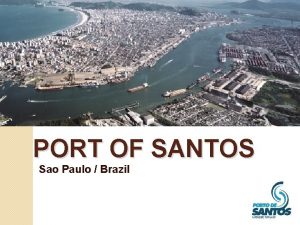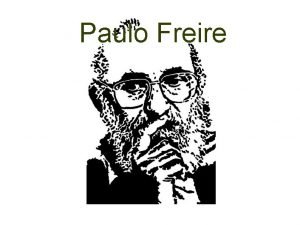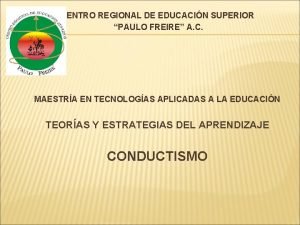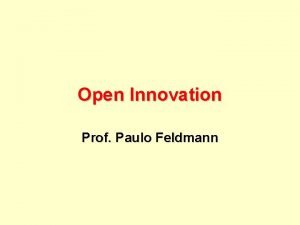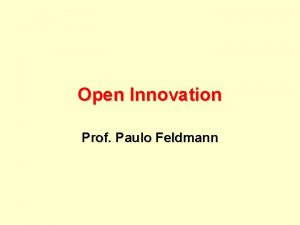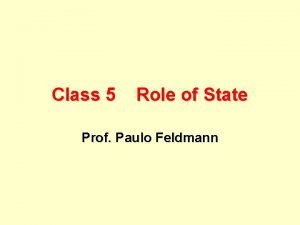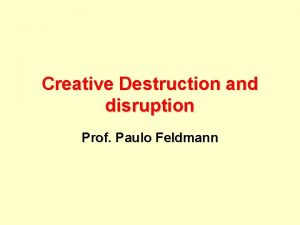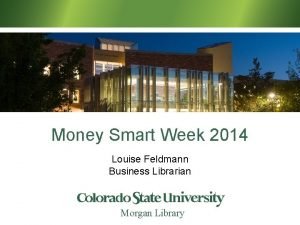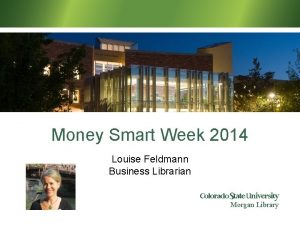Class 1 Economics of Innovation Prof Paulo Feldmann
































- Slides: 32

Class 1 – Economics of Innovation Prof. Paulo Feldmann

Moreover a bit of History. . . 20 18 16 14 12 10 8 Taking off Income per capita in the Western Europe (X 1000 pounds) And important events in the second millennium Compass: navigation throughout the year in the Mediterranean Sea After 1250. Firsts telescopes: Christian Huygens invents The clock pendulum (1658) Halter (around 1100): first mill registered with vertical candles Turning around the horizontal axes. The press of Gutemberg The register of lands known as Domesday Book ordered by William, the Conqueror William shows that there were 5624 mills in 1086, in England, to the south of the river Severn. 1000 1050 1100 1150 Source: Angus Maddison: IMF 6 Alessandro Volta’s electric battery (1800); electromagnetic telegraph (1833); First transatlantic telegraphic cable (1858); Graham Bell’s telephone (1876); Edison’s lamp (1878); patent without string of Guglielmo Marconi (1896). Furnace of casting Advances in Large-scale Hydraulic engineering the Languedoc channel Links the Atlantic and the Mediterranean Sea (1681). Mechanization in the agriculture; steam machines ; cotton spinning wheel of Richard Arkwright (1769); Samuel Crompton’s spinner (1779); Coalbrookdale’s bridge, England, First structure to use cast iron (1779). 4 The process of steel production of Bessemer and Siemens. Martin. 2 Car powered by internal Combustion engine (1885); Model T of Henry Ford (1908) Mechanical propulsion flight (1903) 1200 1250 1300 1350 1400 1450 1500 1550 1600 1650 1700 1750 1800 1850 1900 1950 2000 2 0

The traditional economic theories developed until the 50’s/70’s, focused in labour, capital and raw materials. They used to say when you increase a bit more of each of those inputs, the production increases. The technological considered. change was not 3

Economists took too long to realize that the big factor that defines which country will be successful and which will fail is TECHNOLOGY. The most important question today is how to make Nations become centers that generate technology and knowledge. 4

5

6

Invention X Innovation • Invention: the first concept of a product or process. • Innovation: Introduction or modification of a product or process in the productive sector, with consequent commercialization (The first commercial application or sale). 7

Discovery • Identification and/or explanation of the phenomenon of nature. (scientific knowledge) • Scientific knowledge is public domain. 8

Technology • Technology is the organized group of all knowledge – scientific, empirical or intuitive – used in the production and/or commercialization of goods and services. • The domain of Technology, in other words, the group of specific knowledge that allows for the elaboration of the instructions necessary to produce goods and services. It just happens that the word technology has been widely used to designate these instructions, and not the knowledge that they generate, causing great harm for the correct treatment of this subject.

Some Characteristics • When a company places the latest model of an imported machine to make pleats, some make the mistake of saying that the country has the latest technology to make pleats. Truthfully the country is gifted with the latest instructions to make pleats. • Not always is the technology linked to the scientific knowledge. For example: the invention of the container did not involve any science.

Myths about Innovation • 1. Innovation is always • 1. Not always. the creation of products. • 2. It is essential but it • 2. Innovation comes must it must have from creativity. good execution, discipline, focus and leadership. • 3. Innovation is expensive and takes • 3. Not innovating is up time more expensive. • 4. You need thousand • 4. True. of ideas because failure is great. • 5. Good execution • 5. Only good guarantees high 11 execution is not the success rates.

Innovation and Technology impacts: • The economy and society as a whole. • The companies – in the production function – in the costs – in the competitive advantage and in competition with rivals. 12

Technology is not neutral It always favoured some and made others fall. (URSS). It was like that in the XX century and it will continue to be in the XXI century. 13

Some innovations that affected the Economy and promoted the Globalization in the last 113 years • • • • • 1906 - Airplane 1911 – Taylor’s Principles 1913 – Assembly line 1914 – Radio transmission 1931 – Quality Statistic Control 1933 - Nylon 1934 – Television 1938 – Credit Card 1946 - Computer 1947 - Transistor 1954 - Commercial Jet/Boeing 707 1955 – Optic Fiber 1958 – Integrated circuit 1964 - Fax 1969 - Arpanet Internet 1979 – Commercial cell phone 1993 - Windows 1995 – Transgenic Tomato 2000 – Genome 2003 - Google 2005 – Skype 2009 - Uber, Waze and digitalization of everything 14

Some Important Economists in terms of Technology and Innovation- there are many others • • 1. David Ricardo 2. Karl Marx 3. Alfred Marshall 4. Joseph Schumpeter - (Kondratiev) 5. John Galbraith 6. Robert Solow 7. Joseph Stiglitz 8. Paul Romer

The Theory of Comparative Advantage David Ricardo ( in the XIX century) • Comparative Advantage: A country has a comparative advantage in the production of some goods if it can produce it with an opportunity cost less than any other country.

Producing shirts in the United States or in Bangladesh ? • Despite taking many less hours to produce a shirt in the United States than in Bangladesh the cost of opportunity in the United States is much greater because much will have to be sacrificed to produce other goods. And because of this it is advantageous in the United States to buy shirts that were produced in Bangladesh.

When the commerce between two countries is beneficial to both ? • Always when one country is relatively better than the other in the production of goods. Being relatively better means having the skill to produce goods with a lower opportunity cost, in other words, as a lesser sacrifice than other goods not produced.

Roses or Computers? • The flowers sold in the United States come from Colombia because the opportunity cost to produce a rose in Colombia is cheaper than in the United States. Nonetheless, all the computers sold in Colombia come from the United States as the cost for the opportunity to manufacture computers in the United States is cheaper than in Colombia.

The 3 sources of Comparative Advantage • 1. Climate - Oranges in Brazil • 2. Availability of Factors – Capital - Banks in England – Labor – Textiles in China – Raw Material – Steel in Brazil • 3. Technology watches software in the USA and Swiss

An ideological point of view • When countries specialize in accordance to their comparative advantages, the resources of the world get used more efficiently, allowing for gretaer production of all goods.

Alfred Marshal • As far as you increase production the average costs decreases 22

Economies of Scale • When the marginal cost is less than average cost, there are economies of scale • Average cost declines with output • If average cost increases with output we have diseconomies of scale

Karl Marx • The inexorable tendency to the reduction of profits and the predominance of oligopolies and monopolies. • Technology increases profit but unemploys. 24

Robert Solow • Solow stated that a good part of GDP growth was not due to capital, not even the labor nor the raw material. According to him it was because of knowledge and innovation. This was known as Solow’s Residue and he won the Nobel Prize in 1987 due to this concept. 25

Paul Romer • A worker with less knowledge will produce less than a worker with access to modern knowledge. • From the importance of investment in education. 26

Galbraith • The irreversible tendency of the dominion of the large company. • The small company cannot hire engineers.

SCHUMPETER used to see Capitalism moving in long waves: Every 50 years, approximately, technologic revolutions can cause “Strong Winds of Inventive Destruction” and during them consolidated sectors can be swept and replaced by other totally new sectors. 28

The 5 “WAVES” of industrialization (Notice the Geography) Wave: First Second Third Forth Fifth Beginning and End 1770/80 to 1830/40 to 1880/90 to 1920/30 to 1970/80 To ? Description mechanization Steam power and railway Electric energy, Heavy engineering Mass production, “fordism” I. T. s Key-factor Cotton and cast iron Coal and transport steel Raw oil and derivatives microelectronic, Digital technology Leverager Growth Sectors Clothes and Equipments, Iron casting and molding. Hydraulic energy Steam machines and boats, Railway equipments Electric engineering and equipments , heavy engineering and equipments Cars and trucks, tractors and tanks, Aerospace industry, Durable goods, petrochemicals Informatic and telecomunications equipment, Robotic, info intensive services, softwares Infra-structure Channels, roads railway, World navigation Electric energy highways, aeroports Nets and systems “information highways” Other services growing fast Steam machines, machinery steel, Electricity, gas, Petrochemical sythetic dyes, Heavyt engineering Car and aerospace drugs, industry, Nuclear energy, radio and telecomunications, microelectronic, metals and light alloys, telecomunications Durable goods, Oil e plastics Leader countries UK, France and Belgium UK, France, Belgium, Germany, the USA, UK, Germany and the USA France, Belgium, Switzerland Holland biotechnology, nanotechnology, Spatial activities The USA, Germany, other Japan, the USA, Countries from EEC, Japan, Germany, other countries Russia, Sweden, Switzerland. From EEC, Taiwan, Korea 29

DEGREE OF TECHNOLOGICAL DIFFUSION GREAT WAVES OF TECHNOLOGICAL INNOVATION Period of Installation Point Of Reversal Great Previous Wave Period of Operation Maturity Synergy Euphoria Next Great Wave Beginning of Great Wave Leap of Innovation Source: Basic Data - Carlota Perez Crash Institutional Adjustment New Leap of Innovation TIME

All Classes – Main Subject • 1. Introduction and Basics • 2. Environment, Geography, Culture and Institutions • 3. Relation between Economy and Technology. Productivity in USA. • 4. Public Policies , Latin America /Brazil • 5. Role of state. China • 6. Different Industries/Sectors • 7. Size of companies as a factor to innovate 31

All Classes - Main Subject • • • 8. Organization of companies to innovate. 9. Management of innovative companies. 10. Entrepreneurship 11. Startups and small companies 12. Innovative companies in emerging countries. • 13. Open Innovation and Search of knowledge. • 14. Social Impacts and Others 32
 Klaus feldmann familie
Klaus feldmann familie Chuta sano
Chuta sano Mysite.socccd
Mysite.socccd Disruptive and radical innovation
Disruptive and radical innovation Maastricht university school of business and economics
Maastricht university school of business and economics Elements of mathematical economics
Elements of mathematical economics Un bonito cuento de paulo coelho
Un bonito cuento de paulo coelho Paulo magina
Paulo magina Paulo frayer
Paulo frayer Paulo frayer
Paulo frayer Un bonito cuento de paulo coelho
Un bonito cuento de paulo coelho Paulo sancho
Paulo sancho Primeira viagem missionária de paulo e barnabé
Primeira viagem missionária de paulo e barnabé Latitude and longitude of sao paulo
Latitude and longitude of sao paulo Paulo roberto gaefke
Paulo roberto gaefke Paulo reglus neves freire
Paulo reglus neves freire Paulo freire born
Paulo freire born Paulo roberto gaefke wikipedia
Paulo roberto gaefke wikipedia Certo dia o professor marcos
Certo dia o professor marcos Primeira viagem missionária de paulo
Primeira viagem missionária de paulo Palabra generadora ejercicios
Palabra generadora ejercicios O que é ser honesto
O que é ser honesto Hino da caridade de são paulo
Hino da caridade de são paulo Paulo frayer
Paulo frayer Paulo rossi menezes
Paulo rossi menezes Alfabetización paulo freire
Alfabetización paulo freire Fechando ciclos paulo coelho
Fechando ciclos paulo coelho Buscar imagem
Buscar imagem Paulo cabello
Paulo cabello Centro regional de educación superior paulo freire
Centro regional de educación superior paulo freire Casa butanta paulo mendes
Casa butanta paulo mendes Universidade federal de osasco
Universidade federal de osasco Ine22 são paulo
Ine22 são paulo













